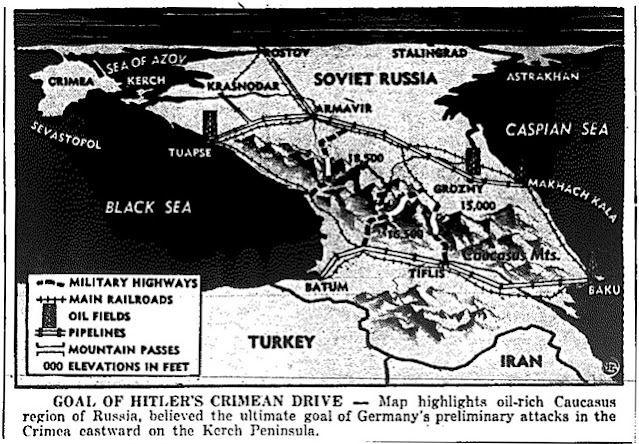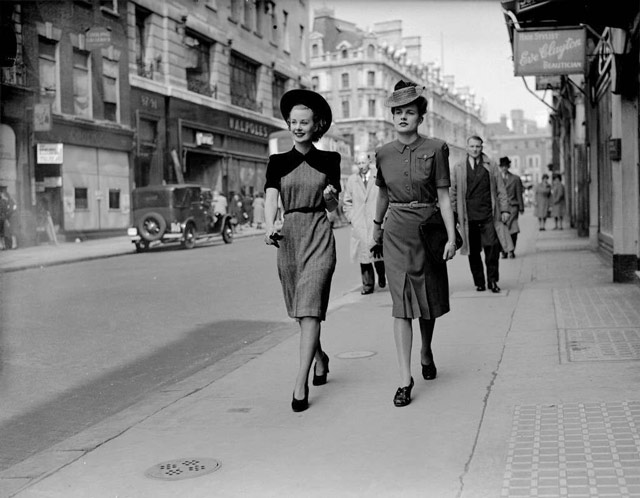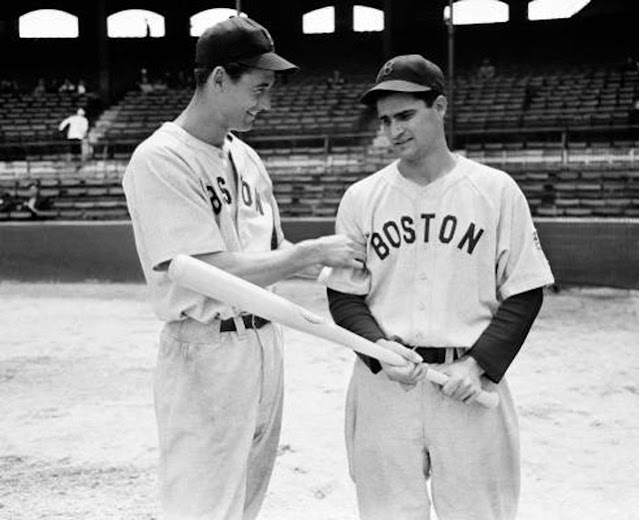Thursday 14 May 1942
 |
| HMS Trinidad after being fatally damaged by Luftwaffe bombers in the Barents Sea on 14 May 1942. It had to be scuttled. |
Battle of the Pacific: On 14 May 1942, the Commander in Chief, United States Navy, and Chief of Naval Operations Admiral Ernest J. King strongly suspects that the Japanese are planning another big operation. He instructs Admiral Chester Nimitz to declare a state of "Fleet Opposed Invasion" and gives Nimitz complete control of all military resources in the central Pacific, including those in the Hawaiian Islands. There is a growing consensus within the naval intelligence service that the next Japanese moves will be toward Midway Island and Dutch Harbor in the Aleutian Islands, but this is not yet absolutely certain.
Led by the naval intelligence office in Hawaii, HYPO, naval codebreakers in Washington and at Station CAST in Melbourne, Australia, have cracked the main Japanese fleet code, called JN-25B. Unfortunately, even reading the Japanese communications in plain language does not completely reveal where the attack will take place. The Japanese refer to their next main target cryptically as being at "AF." Unfortunately for the codebreakers (but a sign of good code discipline by the Japanese), the messages do not identify where AF is. Different people in naval intelligence come up with different theories, but there is no certainty.
 |
| "Rear Admiral Richmond Kelly Turner, USN (left), and Major General Alexander A. Vandegrift, USMC. Working on the flag bridge of USS McCawley (AP-10), at the time of the Guadalcanal-Tulagi operation, circa July-August 1942." Naval History and Heritage Command 80-CF-112-4-63. |
The head of the War Plans Division in Washington, D.C., Admiral Richmond K. Turner, does not believe the conclusion by HYPO and CAST that Midway is the target. Instead, he relies on the Navy's main codebreaking unit in Washington, OP-20-G (Station NEGAT), which draws a different conclusion. Perhaps influenced by Turner's personal preconceptions and beliefs, the station concludes that AF is the Hawaiin Islands and not Midway. Wherever AF is, other decrypted communications have established that it is going to be bombed, strafed, and subjected to an amphibious assault before too long, so everyone understands the urgency.
Turner has complete control over OP-20-G and forbids its members from disseminating any interpretation of AF as Midway Island. The situation turns into a classic bureaucratic turf war with everyone determined to make their point of view prevail. At HYPO in Hawaii, Commander Joseph J. Rochefort sees how Turner (who has caused Rochefort problems in the past) is distorting the intelligence results and resolves to force Turner to accept the evidence as he sees it.
Rochefort consults his staff members for ideas on how to break the logjam. One of them, Jasper Holmes, comes up with the idea of planting news of a false water shortage crisis at Midway in order to see if that will dupe the Japanese into unknowingly revealing the identity of AF. Following military protocol, Rochefort takes the idea to his superior, Chief Intelligence Officer Edwin T. Layton, who then mentions it to Admiral Nimitz. Nimitz ultimately likes the idea and approves it.
 |
| USS Saratoga at the Puget Sound Navy yard, 14 May 1942. If you look closely at the upper right, you also can see an unidentified battleship (US Navy). |
All of this will take a couple of weeks to set up and get the necessary approvals. Nimitz orders a message sent to Midway using an undersea cable (that the Japanese presumably aren't reading) telling them to send a false radio message about a water shortage. They will do this using a code the Japanese are known to have broken. Just to "get the message out" further, Midway also sends an uncoded radio signal about the water shortage. This sets in motion one of the greatest military intelligence successes of World War II.
Nimitz also engages in his own game of bluff with the Japanese. Since the intelligence is hardening that the next Japanese objective is Midway, he needs Admiral Halsey's Task Force 16 ready for it. Halsey, however, is still east of the Solomons to counter the expected Japanese invasions of Nauru and Ocean Island. Nimitz orders Halsey to make sure the Japanese see his ships. Once that is accomplished, Halsey is to head back to Pearl Harbor and prepare for the Midway battle. Nimitz also places eight submarines along the suspected path of Japanese carriers Zuikaku and Shōkaku.
Fifth Air Force sends B-17 and B-26 bombers to attack Rabaul and Lae.
Battle of the Indian Ocean: British forces retreating in Burma are congregating at the border town of Tamu. The Japanese are content to solidify their control of the rest of the country, where there are still scattered Allied units that have not yet reached safety.
While the Allied ground forces in Burma are retreating, the US Army Air Force 10th Air Force is on the offensive. Several B-17 bombers attack Myitkyina for the second time. Extensive damage is done to airport runways and buildings.
 |
| The Charlotte News, 14 May 1942. |
Eastern Front: After a very dangerous start to the battle at Kharkov for the Germans, they begin to regain their equilibrium and blunt the Soviet drive west. While the Luftwaffe remains badly outnumbered over the battle, it gradually succeeds in establishing air superiority. On the Soviet side, Marshal Semyon Timoshenko is forced to bring up his reserve air units, which also are quickly ground up. Gaining control of the air enables the Luftwaffe's ground attack planes called up from Crimea to attack effectively. At Fuhrer Headquarter, General Franz Halder indicates the view there that the situation south and east of the city is the crisis point.
The Soviets are attacking along two fronts on either side of Kharkov, across the Barvenkovo River in the north (Soviet Southwestern Front) and from a Soviet projection into the front at Izyum (the "Izyum Bulge) to the south (Southern Front). The plan requires both pincers to advance and meet to the west of Kharkov. In the Soviet view, one of the main purposes is simply as a spoiling attack to prevent the Germans from launching a major offensive toward Moscow. What the Soviets don't realize is that the Germans have no immediate plans for Moscow and instead have, like them, concentrated their power along the southern sector of the front - right where the Red Army is attacking.
The Germans are having their greatest success in slowing the offensive on the northern sector despite the Soviets initially having more success there. The Germans are attacking Soviet pincers in several localized offensive using fresh reserves that, because of the early Red Army successes there, have been sent to the north pincer rather than the southern one.
 |
| A map of the Caucasus from the 14 May 1942 The Charlotte News. |
Hitler discusses the Kharkov situation with General Ewald von Kleist, in command of the 1st Panzer Army along the southern salient. He tells Kleist to use the 3rd Panzer Corps in a quick counterattack toward the base of the Soviet breakthrough. The options are to try to contain the Soviets or to cut them off. Typically, Hitler prefers the latter option. If it succeeds, it potentially would encircle the Soviet troops in the south. However, if it fails, the summer offensive is off and the strategic situation radically deteriorates for the Reich. Allowing the Soviet offensive to mushroom to the west while trying to cut off the Red Army's communications to the east is a bold strategy that will either lead to a brilliant victory or a debilitating defeat.
In Crimea, meanwhile, the Soviet defense is collapsing. General Erich von Manstein has three divisions approaching Kerch today, threatening the only good Red Army escape route. However, Hitler still mandates a full Luftwaffe effort there at the expense of the Kharkov front.
European Air Operations: A lull in operations by both sides continues, most likely due to the weather.
 |
| U-84 enters the submarine pen at Brest, 14 April 1942 (Federal Archive Fig. 101II-MW-4905-07). |
Battle of the Atlantic: U-564 (Kptlt. Reinhard Suhren), on its fifth mission out of Brest, torpedoes and sinks Mexican tanker Potrero del Llano off Cape Florida. This is a mistake, as Mexico is a neutral country. While watching the ship early in the morning, Suhren misreads the Mexican flag as Italian (which, due to the variation of the flag being flown, is an easy mistake to make). In any event, Suhren, not realizing the ship is Mexican, decides it is a legitimate war target. He torpedoes Potrero del Llano, causing 13 deaths and 22 survivors, who are picked up by USS PC-536. This sinking causes a diplomatic incident between Mexico and Germany. After another sinking on 20 May 1942, Mexico declares war two days later.
After being bombed and damaged in the Arctic Ocean by the Luftwaffe on 14 May 1942 and then running into one of its own torpedos, 8821-ton Royal Navy cruiser HMS Trinidad, now trying to return to the UK for permanent repairs and with speed reduced to 20 knots, is attacked by 20+ Ju-88s. One bomb hits near the previous damage and starts a fire that gets out of control. It must be scuttled by HMS Matchless the next day. There are 63-69 deaths, including 4 Czech airmen.
U-507 (KrvKpt. Harro Schacht), on its second mission out of Lorient, torpedoes and damages 4148ptno Honduran freighter Amapala in the Gulf of Mexico. US Coast Guard Cutter Boutwell takes Amapala in tow, but it eventually sinks. There are one death and 57 survivors, rescued by patrol aircraft and fishing schooner Gonzalez.
U-155 (Kptlt. Adolf Cornelius Piening), on its second patrol out of Lorient, torpedoes and sinks 2483-ton Belgian freighter Brabant in the Caribbean southwest of Grenada. There are three deaths and 34 survivors.
U-162 (FrgKpt. Jürgen Wattenberg), on its second patrol out of Lorient, torpedoes and sinks 6917-ton British tanker British Colony 90 nautical miles (170 km) northeast of Bridgetown, Barbados. There are four deaths and 43 survivors.
U-125 (Kptlt. Ulrich Folkers), on its fourth patrol out of Lorient, torpedoes and sinks 2493-ton Honduran freighter Comayagua in the Caribbean 14 nautical miles (26 km0 southwest of Grand Cayman Island. There are seven deaths and 35 survivors, who are rescued by British freighter Cimboco.
U-506 (Kptlt. Erich Würdemann), on its second patrol out of Lorient, torpedoes and damages 6821-ton US tanker David McKelvy 35 nautical miles (65 km) south of the Mississippi River. While the ship is beached on the Louisiana coast, it is written off. There are 17 deaths and 25 survivors, who are rescued by USCGC Boutwell.
German minesweeper M 1307 Neufisch I hits a mine and sinks off Esbjerg, Denmark. There are eight deaths.
 |
| The commander of U-84, Horst Upholff (center) and Heinrich Lehmann Willenbrock (left) upon U-84's return from a patrol on 14 May 1942. U-84 sank two ships of 8,240 tons on the patrol (Federal Archive Image 101II-MW-4905-23). |
Battle of the Mediterranean: Greek 6692-ton freighter Mount Olympus hits a mine and sinks off Port Said. There are three deaths and 27 survivors.
British submarine HMS Turbulent sinks 243-ton Italian schooner San Giusto. There are 1 death and 11 survivors.
Air attacks continue against Malta despite its improved air defenses. RAF pilots John "Tony" Boyd and Colin Finlay are shot down and killed.
Battle of the Black Sea: Soviet 1326-ton destroyer Dzerjinsky hits a mine and sinks off Sevastopol. There are 260 deaths.
Special Operations: Operation Fritham takes place. This is a Norwegian attempt, launched from the River Clyde aboard ice-breaker D/S Isbjørn and the sealer Selis, to secure coal mines on Spitsbergen, Svalbard. The icebreaker turns out to be absolutely necessary, as the bay is covered in ice. The two ships are discovered almost immediately by a Junkers Ju 88 reconnaissance plane. Before the ships can make it to their destination, however, four FW 200 Condor bombers arrive and sink the icebreaker and set the other ship on fire. No equipment can be rescued from the ships.
With thirteen men dead and nine others badly wounded, the remaining crews take refuge in nearby houses abandoned since Operation Gauntlet in 1941. This essentially ends the effectiveness of the operation, and it turns into a survival exercise that ultimately is ended without results.
Spy Stuff: U-213 (Oblt. Amelung von Varendorff), on its second patrol out of Lorient, has been laying mines near St. John's, Newfoundland, but it has a passenger who it lets off near the town of St. Martins, New Brunswick. This Lieutenant M.A. Langbein, who has documents identifying him as "Alfred Haskins" of Toronto, Ontario. Langbein's role is to monitor convoys leaving Halifax, Nova Scotia.
Once ashore, Langbein acts in a very un-spy fashion. He destroys his radio and makes it to Ottawa, Ontario, which isn't the best place to observe convoys from. Langbein ultimately surrenders himself to authorities late in 1944, having done no spying but having run through the thousands of dollars his spymasters have provided him.
 |
| President Franklin D. Roosevelt approved legislation establishing the Women’s Army Auxiliary Corps (WAAC), 14 May 1942. |
US Military: President Roosevelt signs legislation authored by Massachusetts Republican Rep. Edith Nourse Rogers creating the Women’s Army Auxiliary Corps. It authorizes a voluntary enrollment program for up to 150,000 women in non-combat roles. Under the WAAC umbrella, women fill a variety of jobs including as medical care professionals, welfare workers, clerks, cooks, messengers, military postal employees, chauffeurs, and telephone and telegraph operators. In 1943, this evolves into the Women's Army Corps.
Full convoys begin along the US East Coast. The first convoy departs from Hampton Roads, Virginia, to Key West, Florida.
Australian Homefront: Food and clothing rationing to begin.
American Homefront: The Cincinnati Symphony Orchestra premieres Aaron Copeland's "Lincoln Portrait." The piece includes narration that is often handled by celebrities such as Tom Hanks, Charlton Heston, and James Earl Jones.
Future History: Atanacio Pérez Rig is born in Ciego de Ávila, Cuba. As a boy, he plays baseball for the team of the sugar mill that employs his father, and, eventually, he works. In 1960, Cincinnati Reds scout Tony Pacheco sees him playing on the sugar factory team and signs him to a contract with the Reds' instructional team in Havana. Known professionally as Tony Pérez, he does well, sets various team batting records in the Reds' system, and is called up to the major league team on 26 July 1964. Tony Pérez goes on to a Hall of Fame career, including being a seven-time all-star and a three-time World Series champion. He has his uniform number (No. 24) retired by the organization. Perez also has managed the Florida Marlins. As of 2021, Tony Perez remains closely associated with the Reds organization.



No comments:
Post a Comment